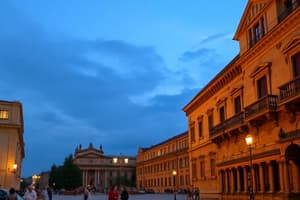Podcast
Questions and Answers
What does Barroco mean?
What does Barroco mean?
- Rich in detail and thought (correct)
- Modern and minimalistic
- Dark and gloomy
- Simple and plain
What are the main ideas present in El Barroco Peninsular?
What are the main ideas present in El Barroco Peninsular?
Doubt, disenchantment, concern for time, and loss of trust in Renaissance ideals.
El Barroco de Indias is an artistic movement in ___ .
El Barroco de Indias is an artistic movement in ___ .
America
What period does the Siglo de Oro refer to?
What period does the Siglo de Oro refer to?
What were some characteristics of the culture during the Siglo de Oro?
What were some characteristics of the culture during the Siglo de Oro?
The public of the Siglo de Oro was homogeneous in character.
The public of the Siglo de Oro was homogeneous in character.
Who inspired rebellion leading to the independence of new American republics?
Who inspired rebellion leading to the independence of new American republics?
Despotismo Ilustrado translates to '___ for the people, but without the people'.
Despotismo Ilustrado translates to '___ for the people, but without the people'.
Who was Goya and what was his contribution during the period of Ilustración?
Who was Goya and what was his contribution during the period of Ilustración?
What was a significant tension during the Ilustración period?
What was a significant tension during the Ilustración period?
Flashcards are hidden until you start studying
Study Notes
El Barroco Peninsular and Barroco de Indias
- Barroco represents richness in detail and thought.
- El Barroco Peninsular emphasizes doubt, disenchantment, and concerns about time, highlighting a loss of faith in Renaissance ideals.
- Key writers include Lope de Vega and Cervantes, who challenged norms of the time.
- This era was marked by tensions such as mysticism, doubt, social inequality, and an imperial dream juxtaposed with Spain's struggles.
- Barroco de Indias, an artistic movement in America, featured depth in carving but a flattened appearance, integrating native elements and symbols alongside European influences.
- Notable example: San Lorenzo, an architectural record of the period.
- Sor Juana, recognized as the first Mexican literary figure, exemplifies societal doubts through her writings.
Characteristics and Tensions of the Siglo de Oro
- The Siglo de Oro (1550-1650) denotes a "golden age" in Spain, following the Renaissance.
- Contradictions between reality and perception of Spain, with excessive focus on power leading to overextension.
- Velázques introduced social criticism, presenting his personal worldview in his art.
- Themes of disenchantment manifested in painting, often featuring skeletons and globes reflecting somber contemplation of life.
- Mysticism emerged as a direct relationship with God, challenging the influence of the church.
- The concept of Hidalgo illuminated social class issues, questioning strict class structures and the position of the low noble class.
- Barroco art served to represent the lower classes often overlooked by society.
- El Greco’s work characterized by negativity, dull colors, and a stark view of reality, pushing against prior divine portrayals.
Public of the Siglo de Oro
- The urbanized public during the period was diverse and capable of consuming cultural products.
- Coral de comedias represented the first permanent theater, welcoming audiences from various social statuses.
- The printing press allowed greater access to information for the largely illiterate population, facilitating the spread of new ideas and interpretations.
- Increased accessibility posed a threat to traditional power structures as new thoughts circulated widely.
Factors Leading to Independence of New American Republics
- Napoleon's rise caused unrest among the American colonies due to French influence.
- Indigenous uprisings (e.g., palenque and quilombo) from 1508-1888 were crucial.
- Criollos played pivotal roles in promoting independence, highlighted by Father Hidalgo’s rallying cry against Spaniards.
- The concept of popular sovereignty emphasized the rule of the people, fueling rebellion efforts starting in 1810.
- High taxation and disenchantment contributed significantly to a desire for independence.
- Figures like Tupac initiated rebellions, while Bolivar united llaneros, influencing Venezuela's struggle against Spanish unity.
Tensions and Conflicts of the Peninsular Enlightenment
- Enlightenment inspired hope through reason, science, education, and economic growth.
- Core principles included freedom, equality, and human rights, alongside a challenge to traditional values.
- Agricultural, commercial, and infrastructural reforms faced opposition, reflecting societal discord.
- Francisco Goya’s art illustrated the period's tensions, offering social critique through unsettling imagery, particularly in his "pinturas negras."
- Jovellanos advocated for Enlightenment ideals amidst political resistance.
- Despotismo Ilustrado highlighted the conflict of implementing reforms while suppressing public consent.
- The Cádiz Constitution marked a significant political reform, though compromised by Napoleon's invasion and subsequent disillusionment.
Studying That Suits You
Use AI to generate personalized quizzes and flashcards to suit your learning preferences.




